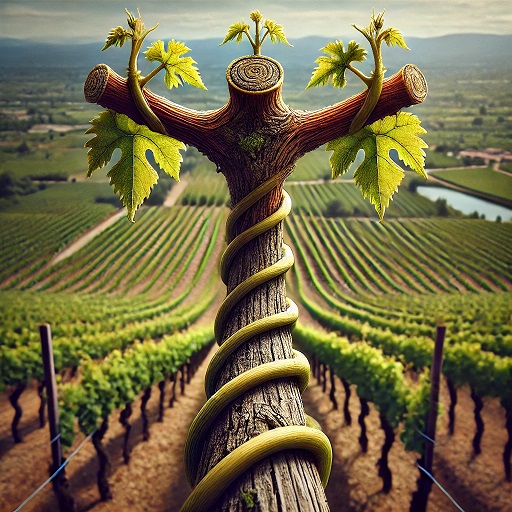Canopy Management
Pruning, Training and Trellising


Grapevines must be pruned and trained annually to achieve this goal.
Pruning
Grapevines fruit on one year canes.
Annual pruning is required to maintain a productive vine.
Pruning can remove up to 90% of the vine growth each year.
There are two basic methods of pruning: Cane pruning and Spur pruning.
Winter Pruning
The principal pruning of the vine is done while the plant is dormant, between the fall of the leaves at the beginning of winter and the starting of the buds at the beginning of spring.
Cane Pruning (Cutting Canes)
Cane pruning refers to cutting a grapevine down to one or more canes that will later produce new shoots.
After pruning, the vine is left with a trunk and one or two canes. (one for the current year, and one for the renewal of spurs).
Cane pruning is used for varieties which will not bear well on short spurs. It requires a permanent horizontal trellis consisting of a well-supported horizontal wire at about 30 to 40 inches from the ground to which the fruit-canes are attached in order to increase their fruitfulness and to prevent them from shading the renewal spurs which need sunlight to produce good fruit canes for the following year. A similar wire is usually placed about 12 inches above the first to support the growing shoots. This system is fairly simple to establish but vines pruned by it are the most difficult to keep in shape when they become large.



Spur Pruning (Cutting Spurs)
Spur pruning refers to cutting a grapevine down to two to four buds on one year old wood that originates across the length of the fruiting cordon. Spur Pruning is also called Cordon Pruning (cutting the spurs on the cordon)
Spur pruning is necessary for varieties which do not bear sufficiently on spurs and which produce grapes of inferior quality on canes. It is useful also for most vigorous, large-fruited varieties of table grapes. It requires a permanent trellis similar to that used in cane pruning to support the horizontal trunk. Some of its advantages are that it increases the fruitfulness of the canes so that nearly all varieties will bear on the lowest buds, and that it promotes large size of the berries and bunches, and high uniform quality. It is the most laborious of the three to establish during the first four years, but, when established, it is the simplest and perhaps the most economical to maintain.

Maggy Wassilieff - Te Ara - The Encyclopedia of New Zealand
Head Pruning (Cutting the Head)
With head pruning the vine is given the form of a small selfsupporting tree or bush. The fully formed vine consists of an upright "trunk," 30-90 cm high (1-3 feet), dividing at the top into a ring of 4 to 8 ascending "arms," 6 to 18 inches long. At the end of each of these arms is left at the winter pruning 1 or 2 "spurs" consisting of 1, 2, or 3 joints of the basal portions of the "canes" which grew the preceding summer.
Where head pruning is adopted, the vines require no trellises and may therefore be planted so that cross cultivation is possible. Stakes are necessary at first, but they can usually be discarded after 4 to 6 years when the trunks of the vines have developed sufficiently to be self-supporting. This is the easiest system to establish, but considerable care and skill are required to keep the vines in shape as they grow older.